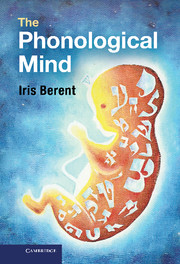Book contents
- Frontmatter
- Contents
- Figures
- Tables
- Copyright acknowledgements
- Preface
- Part I Introduction
- Part II Algebraic phonology
- Part III Universal design
- Part IV Ontogeny, phylogeny, phonological hardware, and technology
- 9 Out of the mouths of babes
- 10 The phonological mind evolves
- 11 The phonological brain
- 12 Phonological technologies: reading and writing
- 13 Conclusions, caveats, questions
- References
- Index
13 - Conclusions, caveats, questions
Published online by Cambridge University Press: 05 February 2013
- Frontmatter
- Contents
- Figures
- Tables
- Copyright acknowledgements
- Preface
- Part I Introduction
- Part II Algebraic phonology
- Part III Universal design
- Part IV Ontogeny, phylogeny, phonological hardware, and technology
- 9 Out of the mouths of babes
- 10 The phonological mind evolves
- 11 The phonological brain
- 12 Phonological technologies: reading and writing
- 13 Conclusions, caveats, questions
- References
- Index
Summary
Finally, his time has come, the same angel approaches him and says to him: “Do you recognize me?” And the man tells him: “Yes.” And says: “Why did you come to me today of all days?” “To remove you from this world since it is your time to abate,” says the angel. Immediately he begins crying, and sounds his voice from one end of the world to the other. And no one recognizes or hears his voice, except the rooster alone. And he tells the angel, “You had already removed me from two worlds and brought me into this one.” And the angel tells him, “But I had already told you, against your will you were created, and against your will you were born, and against your will you live, and against your will you die, and against your will you are to give an account before God almighty” . . .
(Midrash Tanhuma, pekudei: 3, translation mine)In this Jewish tradition, innate knowledge and destiny go hand in hand. It is the same angel who had endowed the embryo with knowledge of the entire Torah that now appears to him in old age and summons him to the next world. Recognizing the angel, the man wishes to avert his demise, just as he had previously attempted to prevent his birth. But neither knowledge nor fate is in our hands. And just as man’s vain resistance to his arrival on this earth only resulted in the loss of precious knowledge, so is it futile when it comes to his departure.
While modern science attributes to humans far greater control over their knowledge, the findings reviewed in this book suggest that some forms of knowledge might be nonetheless determined by our biology. But precisely what aspects of our knowledge are universally human, to what extent knowledge is predetermined, and what mechanisms are responsible for its fixation and plasticity are the subject of much debate. This final chapter summarizes my conclusions so far.
- Type
- Chapter
- Information
- The Phonological Mind , pp. 307 - 315Publisher: Cambridge University PressPrint publication year: 2013



